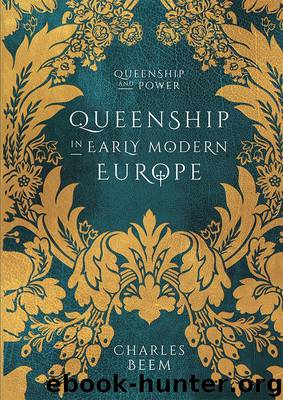Queenship in Early Modern Europe by Charles Beem

Author:Charles Beem
Language: eng
Format: epub
Publisher: Red Globe Press
QUEENSHIP IN THE HOLY ROMAN EMPIRE
Maria Theresa was the inheritor of 200 years of precedent and experience surrounding Habsburg queenship. The Holy Roman Empire was in fact a nexus for the pan-European kinship network of royalty, consisting of hundreds of autonomous German and Italian states, whose nominal prince was an emperor elected by seven imperial electors. In practice, the post was held by the Habsburg family, who, as we have seen, also ruled several Central European states of their own, some of which, like Hungary, Croatia, and Transylvania, lay outside the boundaries of the Holy Roman Empire. In the sixteenth and seventeenth centuries, the Habsburgs attempted to bind the Empire into a more centralized pan-German state.11 The Protestant Reformation complicated this process, with much of northern Germany becoming either Lutheran or Calvinist, creating a form of doctrinal iron curtain which required potential Catholic queen consorts to convert to Protestantism and vice versa. A number of queens challenged this dictum and got away with it, like Henrietta Maria of England and Christiane Eberhardine of Poland (discussed in Chapter 5), while Austrian Habsburgs were absolutely forbidden to marry Protestants unless they converted, as Maria Theresa’s own mother had done prior to her marriage to Emperor Charles VI. Although the Thirty Years War (1617–1647) failed to unify the Holy Roman Empire, it did re-catholicize Bohemia, Silesia, and Moravia, while dynastic ties with the more prominent German Catholic states were continually reinforced by marriage alliances with the Habsburg family.12
Within this framework, the position of Holy Roman Empress emerged as a bastion for post-Tridentine Catholicism, drawing its candidates from Spain, Bavaria, Brunswick-Luneburg (or Hanover), Mantua, and Tuscany. As the preeminent position for a woman in Europe, Holy Roman Empresses followed a basic queenship model that combined intense religiosity with a privileged devotion to fecundity and family while playing an active role within the royal court and serving as marriage brokers for their children and their relatives. On many occasions also, Holy Roman Empresses wielded political power in conjunction with and on behalf of their husbands and sons. Much of Maria Theresa’s success as a ruling queen reflects the collective experiences of her predecessors as Holy Roman Empresses.
This model for imperial queenship owes much to the queenship of Isabella of Castile, whose daughter and heir Juana had married Philip the Handsome of Burgundy, the son and heir of Holy Roman Emperor Maximilian I (r. 1493–1519), which joined the houses of Trastamara and Habsburg. As we have seen in Chapter 1, Isabella’s reputation cast a powerful shadow over Spanish queenship, culminating in the queenship of her namesake granddaughter, Isabel of Portugal, consort of Holy Roman Emperor Charles V, who emulated Isabella’s piety, chastity, and moral probity, all within the confines of a companionate marriage. As regent for her husband in Spain, Isabel wielded a royal prerogative much in accordance with the precedent laid down by her grandmother Isabella. This powerful Iberian model was welded onto the Habsburg monarchy, as the dynasty split into two, with Charles V’s
Download
This site does not store any files on its server. We only index and link to content provided by other sites. Please contact the content providers to delete copyright contents if any and email us, we'll remove relevant links or contents immediately.
| Africa | Americas |
| Arctic & Antarctica | Asia |
| Australia & Oceania | Europe |
| Middle East | Russia |
| United States | World |
| Ancient Civilizations | Military |
| Historical Study & Educational Resources |
Underground: A Human History of the Worlds Beneath Our Feet by Will Hunt(12024)
Sapiens by Yuval Noah Harari(5294)
Navigation and Map Reading by K Andrew(5111)
The Sympathizer by Viet Thanh Nguyen(4305)
Barron's AP Biology by Goldberg M.S. Deborah T(4098)
5 Steps to a 5 AP U.S. History, 2010-2011 Edition (5 Steps to a 5 on the Advanced Placement Examinations Series) by Armstrong Stephen(3689)
Three Women by Lisa Taddeo(3354)
Water by Ian Miller(3128)
The Comedians: Drunks, Thieves, Scoundrels, and the History of American Comedy by Nesteroff Kliph(3039)
Drugs Unlimited by Mike Power(2545)
A Short History of Drunkenness by Forsyth Mark(2233)
DarkMarket by Misha Glenny(2159)
The House of Government by Slezkine Yuri(2159)
And the Band Played On by Randy Shilts(2129)
The Library Book by Susan Orlean(2042)
Revived (Cat Patrick) by Cat Patrick(1963)
The Woman Who Smashed Codes by Jason Fagone(1929)
Birth by Tina Cassidy(1864)
The Absolutely True Diary of a Part-Time Indian by Sherman Alexie(1858)
